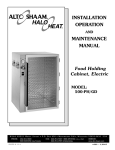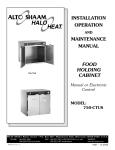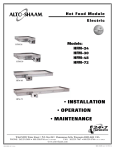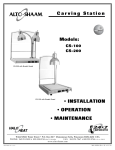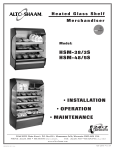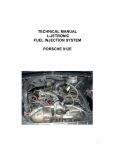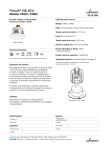Download SERVICE MANUAL
Transcript
SERVICE MANUAL MOBILE HOT HOLDING CABINET MODEL: 1000-MH1 Mobile Hot Holding Cabinet Models: 1000-MH1 DELIVERY/UNPACKING DELIVERY This Alto-Shaam appliance has been thoroughly tested and inspected to insure only the highest quality unit is provided. Upon receipt, check for any possible shipping damage and report it at once to the delivering carrier.See Transportation Damage and Claims section located in this manual. This appliance, complete with unattached items and accessories, may have been delivered in one or more packages. Check to ensure that all standard items and options have been received with each model as ordered. Save all the information and instructions packed with the appliance. Complete and return the warranty card to the factory as soon as possible to assure prompt service in the event of a warranty parts and labor claim. UNPACKING a) Carefully remove the appliance from the carton or crate. NOTE : Do not discard the carton and other packaging material until you have inspected the unit for hidden damage and tested it for proper operation. b) Read all instructions in this manual carefully before initiating the installation of this appliance. DO NOT DISCARD THIS MANUAL. This manual must be read and understood by all people using or installing the equipment model. Contact the Alto-Shaam service department if you have any questions concerning installation, operation, or maintenance. NOTE : All claims for warranty must include the full model number and serial number of the unit. This manual is considered to be part of the appliance and is to be provided to the owner or manager of the business or to the person responsible for training operators. Additional manuals are available from the Alto-Shaam service department. c) Remove all protective plastic film, packaging materials, and accessories from the appliance before connecting electrical power. Store any accessories in a convenient place for future use. Page 1 Alto-Shaam Mobile Hot Holding Cabinet 1.0 INTRODUCTION This technical manual provides information on the installation, operation, maintenance and inspection of this unit. A complete parts breakdown is provided. 2.0 EQUIPMENT DESCRIPTION The unit consist of the following: Storage compartment : The insulated food storage compartment is clear storage area Included in this area are the adjustable shelves. FUNCTIONAL DESCRIPTION This unit is self-contained, automatically controlled, continuous duty perishable food storage system. It is designed with the intent and purpose of storing hot food items. The operating temperature is automatically monitored by controls that are factory-set to maintain a predetermined, adequate condition. The unit consists of two basic compartment assemblies: Storage Compartment which consists of the Doors: Access to the storage compartment is through a hinged-mounted insulated door. 1.2 EQUIPMENT SUPPLIED The unit is shipped from the factory fully assembled except the adjustable shelving that will require positioning on the side racks. The complete assembly is palletized and crated to reduce the possibility of damage in shipping and storage. 1.3 LEADING PARTICULARS Heater: 2 x 750 Watt Electrical : 1000-MH1 insulated clear storage area for perishable food items requiring a temperature range 60° to 71°C. The clear storage area includes adjustable shelving. 2.1 SYSTEM OPERATION The primary focus for the design of the hot cabinet is for the safe storage of food products which require hot. Considerable engineering attention was placed on the qualities of function and serviceability. 3.0 START UP PROCEDURE The hot system is completely factoryassembled, pre-charged and ready for operation. The control has been set to display temperature in degree Celsius as specified on the original order. To energize the system, it is only necessary to locate the power supply cord and connect it to a proper electrical supply source. Once the supply cord has been connected to a power source, the unit can be started by switching the power control switch to the "ON" position. 3.1 SHUT-DOWN PROCEDURE To shut-down, place the power control in the "OFF" position and open the door to allow the cabinet interior temperature to equalize with the room temperature. Use a mild detergent diluted in warm water to wash the interior and exterior surfaces of the cabinet. 220-240VAC 50 Hz, 1∅ 7.0 Amps UL#PS-204N 15A, 250V Plug SG #MP5004 Net 268±22 lb (122±10kg) Shipping 303±22 lb (138±10kg) Page 2 Procedures 3.2 CONTROL AND INDICATION NAME TYPE FUNCTION START-UP PROCEDURE OPERATION Thermostat Cycles the Before operating the unit, clean both the interior and exterior of Hot system(automatic) the unit with a clean, damp cloth and mild soap solution. Contact Points Rinse carefully.Clean and install the shelf slides. Power Control Therminates power Become familiar with the operation of the controls. Switch(ON/OFF) Contact Points to the unit Read this manual and keep it in a secure locations. LCD display Indicates continuous The appliance is equipped with a special heating cable. Through cabinet temperature this Hot concept, the heating cable is mounted against the wall of the unit to provide an evenly applied heat source controlled by a thermostat. The design and operational characteristics of the unit eliminate the need for a moisture pan or a heat circulating fan. Through even heat application, the quality of food products is maintained up to several hours or more. START – UP 1. Connect the electric cord to an appropriate power outlet. 2. Close the compartment vents located on the inside of each 3.3 EXTENDED PERIOD OF INACTIVITY compartment door. This unit is designed for continued use at 3. Press the power ON for the appropriate compartments. automatically cycled intervals. In case of an The power button will illuminate. extended shut-down, the food storage 4. Set temperature for use. compartment must be cleaned and wiped dry to 5. The temperature display light will illuminate when the inside air minmize the potential of odor build-up during reaches the desired holding temperature. shutdown. HOW TO SEE THE SETPOINT 1. Push and immediately release the SET key : the display will show the Set point value ; 2. Push and immediately release the SET key or wait for 5 seconds to display the probe value again. 1000-MH1 HOW TO CHANGE THE SETPOINT 1. Push the SET key for more than 2 seconds to change the Set point value ; 2. The value of the set point will be displayed and the“oC” or “oF” LED starts blinking ; 3. To change the Set value push the or arrows within 10 sec. 4. To memories the new set point value push the SET key again or wait 10sec. Created by factory Page 3 OPERATION HOLDING PROCEDURE 4.0 OPERATING PROCEDURES a) Preheat at 90º C for 30 minutes. d) Reset the thermostat to desired temperature. Allow a minimum of 30 minutes for preheating After the cart has been completely filled with product, before loading the banquet cart with product. check to make certain the doors are securely closed, and reset the thermostat to the desired holding temperature or the suggested 82ºC b) Load the cart with hot food only. The purpose of the Hot Holding Cabinet is to maintain hot food at proper serving temperature. The proper temperature range for the products being held, Only hot food should be placed into the Hot and whether or not to open or close the door vents, will Holding Cabinet. depend on the type and quantity of product.When holding Before loading the cart with food, use a food food for prolonged periods, it is advisable to periodically thermometer to make certain all products have check the internal temperature of each item with a food reached an internal temperature range of 60º To thermometer to assure maintenance of the proper 71ºC. Any food product not within the proper temperature range of 60º to 71ºC temperature range should be heated before loading into the Hot Holding Cabinet. For best results, use a Hot Low Temperature Cooking and Holding Oven set at 121º To 135ºC ,or a Combitherm oven, to bring the product within the correct temperature range. c) Load covered plates or carriers into the Mobile Hot Holding Cabinet. After the food has reached proper serving temperature : - Use HEATED plates only. - Load each series of four (4) plates into the Mobile Hot Holding Cabinet as soon as assembled and as quickly as possible to retain maximum heat. - Load the plates in the upper section of the Mobile Hot Holding Cabinet first. - Securely close the doors of the Mobile Hot Holding Cabinet after loading each series of plates. Page 4 GENERAL OPERATION 5.0 OPERATING HOLDING GUIDELINES Chefs, cooks and other specialized food service HOLDING TEMPERATURE RANCE MEAT FAHRENHEIT CELSIUS personnel employ varied methods of cooking. Proper BEEF ROAST – Rare 140ºF 60ºC holding temperatures for a specific food product must be BEEF ROAST – Med / Well Done 160ºF 71ºC based on the moisture content of the product, product BEEF BRISKET 160º - 175ºF 71º- 79ºC density, volume, and proper serving temperatures. CORN BEEF 160º - 175ºF 71º- 79ºC Safe holding temperatures must also be correlated with PASTRAMI palatability in determining the length of holding time for PRIME RIB – Rare a specific product. STEAKS – Broiled / Fried RIBS – Beef or Pork 160º - 175ºF 140ºF 160º - 175ºF 160ºF 71º- 79ºC 60ºC 71º- 79ºC 71ºC Mobile Hot Holding Cabinet maintains the maximum VEAL 160º - 175ºF 71º- 79ºC amount of product moisture content without the addition HAM 160º - 175ºF 71º- 79ºC of water, water vapor, or steam. Maintaining maximum PORK 160º - 175ºF 71º- 79ºC natural product moisture preserves the natural flavor of LAMB 160º - 175ºF 71º- 79ºC the product and provides a more genuine taste.In addition POULTRY to product moisture retention, the gentle properties of CHICKEN – Fried / Baked 160º - 175ºF 71º- 79ºC Mobile Hot Holding Cabinet maintain a consistent DUCK 160º - 175ºF 71º- 79ºC temperature throughout the cabinet without the necessity TURKEY 160º - 175ºF 71º- 79ºC of a heat distribution fan, evaporation or dehydration. GENERAL 160º - 175ºF 71º- 79ºC FISH / SEAFOOD When product is removed from a high temperature FISH – Baked / Fried 160º - 175ºF 71º- 79ºC cooking environment for immediate transfer into LOBSTER 160º - 175ºF 71º- 79ºC equipment with the lower temperature required for hot food holding, condensation can form on the outside of the product and on the inside of plastic containers used SHRIMP – Fried 160º - 175ºF 71º- 79ºC BAKED GOODS BREADS / ROLLS in self-service applications. Allowing the product to MISCELLANEOUS release the initial steam and heat produced by high CASSEROLES temperature cooking can alleviate this condition. DOUGH – Fried 120º - 140ºF 49º- 60ºC 160º - 175ºF 71º- 79ºC 180º - 100ºF 27º- 38ºC To preserve the safety and quality of freshly cooked foods EGGS – Fried 150º - 1760F 66º- 71ºC however, a maximum of 1 to 2 minutes must be the only FROZEN ENTREES 160º - 175ºF 71º- 79ºC time period allowed for the initial heat to be released from HORS D’OEUVERS 160º - 180ºF 71º- 82ºC the product. PASTA 160º - 180ºF 71º- 82ºC PIZZA Most Mobile Hot Holding Cabinet equipment is provided POTATOES with a thermostat control between 30º to 80ºC PLATED MEALS If the unit is equipped with vents, close the vents for SAUCES moist holding and open the vents for crisp holding. SOUP VEGETABLES 160º - 180ºF 180ºF 180ºF 140º - 200ºF 140º - 200ºF 160º - 175ºF 71º- 82ºC 82ºC 82ºC 60º- 93ºC 60º- 93ºC 71º- 79ºC If the unit is equipped with a thermostat indicating a range The holding temperatures listed are suggested guidelines only. of between 1 and 10, use a metal-stemmed indicating thermometer to measure the internal temperature of the product(s) being held. Adjust the thermostat setting to achieve the best overall setting based on internal product temperature. Page 5 CARE AND CLEANING 6.0 THOROUGHLY CLEAN THE UNIT DAILY The cleanliness and appearance of this unit will Always follow appropriate state or local health contribute considerably to operating efficiency (hygiene) regulations regarding all applicable and savory, appetizing food. Good equipment cleaning and sanitation requirements for foodservice kept clean works better and lasts longer. equipment. a) Disconnect unit from power source,and let cool. NOTE : Avoid the use of abrasive cleaning,compounds, b) Remove all detachable items such as plate chloride based cleaners, or cleaners containing carriers, shelves and side racks. Clean these quaternary salts. Never use hydrochloric acid items separately with a good grease solvent (muriatic acid) on stainless steel. or commercial detergent. Rinse well and dry. c) Clean interior metal surfaces of the unit with a damp, clean cloth and any good commercial detergent or grease solvent at the recommended strength. Spray heavily soiled areas with a water soluble degreaser and let stand for 10 minutes, then remove soil with a plastic scouring pad. Rinse by wiping with a sponge and clean warm water to remove all residue.Remove excess water with sponge and wipe dry with a clean cloth or air dry. Replace side racks and shelves. d) Clean control panel, door vents, door handles, and door gaskets thoroughly since these areas harbor food debris. Rinse by wiping with sponge and clean warm water. Wipe dry with a clean cloth. e) Interior can be wiped with a sanitizing solution after cleaning and rinsing. This solution must be approved for use on stainless steel food contact surfaces. f) To help maintain the protective film coating on polished stainless steel, clean the exterior of the unit with a cleaner recommended for stainless steel surfaces. Page 6 CARE AND CLEANING 7.0 CLEANING AND PREVENTIVE MAINTENANCE PROTECTING STAINLESS STEEL SURFACES It is important to guard against corrosion in the CLEANING AGENTS Use non – abrasive cleaning products designed for care of stainless steel surfaces. use on stainless steel surfaces. Cleaning agents must Harsh, corrosive, or inappropriate be chloride – free compounds and must not contain chemicals can completely destroy quaternary salts. Never use hydrochloric acid the protective surface layer of (muriatic acid) on stainless steel surfaces. Always use stainless steel. Abrasive pads, the proper cleaning agent at the manufacturer’s steel wool, or metal implements will abrade recommended strength. Contact your local cleaning surfaces causing damage to this protective coating supplier for product recommendations. and will eventually result in areas of corrosion. Even water, particularly hard water that contains CLEANING MATERIALS high to moderate concentrations of chloride, will The cleaning function can usually be accomplished cause oxidation and pitting that result in rust and with the proper cleaning agent and a soft, clean cloth. corrosion.In addition, many acidic foods spilled and When more aggressive methods must be employed, left to remain on metal surfaces are contributing use a non – abrasive scouring pad on difficult areas factors that will corrode surfaces. and make certain to scrub with the visible grain of surface metal to avoid surface scratches. Proper cleaning agents, materials, and methods Never use wire brushes, metal scouring pads, or are vital to maintaining the appearance and life scrapers to remove food residue. of this appliance. Spilled foods should be removed and the area wiped as soon as possible but at the very least, a minimum of once a day. Always thoroughly rinse surfaces after using a cleaning agent and wipe standing water as quickly as possible after rinsing. Page 7 MAINTENANCE 8.0 THERMOSTAT ACCURACY The electronic thermostat is a precise instrument If the reading on the thermal indicator does not match and is designed to offer trouble free service. If you the digital display, there may be a problem with the air sensor. suspect the temperature inside the holding See troubleshooting guide in this manual; or call the factory compartment does not match the temperature service department for advice. indicated on the digital display, follow the instructions listed below. a) Check to make certain the unit voltage matches the power source. A power source less than that required to operate the unit will result in inaccurate temperatures. a) Verify the temperature inside the holding compartment with a qualify thermal indicator. - Completely empty the holding compartment. - Make certain the holding cabinet sensor, located inside the holding compartment at the left side of the unit, is completely clean. -Suspend the thermal indicator in the center of the holding compartment. - Allow the temperature set on the electronic thermostat to stabilize for a minimum of one hour before comparing the digital display with the reading on the thermal indicator. DO NOT OPEN THE CABINET DOOR(S) DURING THE TEMPERATURE STABILIZATION PERIOD. Page 8 SANITATION Food flavor and aroma are usually so closely related A comprehensive sanitation program should focus on the that it is difficult, if not impossible, to separate them. training of staff in basic sanitation procedures. This includes There is also an important, inseparable relationship personal hygiene, proper handling of raw foods, cooking to a between cleanliness and food flavor. Cleanliness, top safe internal product temperature, and the routine monitoring operating efficiency, and appearance of equipment of internal temperatures from receiving through service. contribute considerably to savory, appetizing foods. Most food-borne illnesses can be prevented through Good equipment that is kept clean, works better and proper temperature control and a comprehensive program lasts longer. of sanitation. Both these factors are important to build Most food imparts its own particular aroma and quality service as the foundation of customer satisfaction. many foods also absorb existing odors. Unfortunately, Both these factors are important to build quality service as during this absorption, there is no distinction between the foundation of customer satisfaction. Safe food handling GOOD and BAD odors. The majority of objectionable practices to prevent food-borne illness is of critical importance flavors and odors troubling food service operations are to the health and safety of your customers. HACCP, an caused by bacteria growth. Sourness, rancidity, acronymfor Hazard Analysis (at) Critical Control Points, is a mustiness, stale or other OFF flavors are usually the quality control program of operating procedures to assure result of germ activity. The easiest way to insure full natural food flavor is through comprehensive cleanliness. This means good food integrity, quality, and safety. Taking steps necessary to augment food safety practices are both cost effective and relatively simple. While HACCP guidelines go far beyond the control of both visible soil (dirt) and invisible soil (germs). scope of this manual, additional information is available by A thorough approach to sanitation will provide essential contacting: cleanliness. It will assure an attractive appearance of equipment, along with maximum efficiency and utility. Center for Food Safety and Applied Nutrition More importantly, a good sanitation program provides Food and Drug Administration one of the key elements in the prevention of food-borne 1-888-SAFEFOOD illnesses. A controlled holding environment for prepared foods is just one of the important factors involved in the prevention of food-borne illnesses. Temperature monitoring and control during receiving, storage, preparation, and the service of foods are of equal importance. The most accurate method of measuring safe temperatures of both hot and cold foods is by internal product temperature. A quality thermometer is an effective tool for this purpose, and should be routinely used on all products that require holding at a specific temperature. Page 9 SAFETY PROCEDURES AND PRECAUTIONS Knowledge of proper procedures is essential to a) This appliance is intended to cook, hold or process the safe operation of electrically and / or gas foods for the purpose of human consumption. energized equipment. In accordance with generally No other use for this appliance is authorized or accepted product safety labeling guidelines for recommended. potential hazards, the following signal words and symbols may be used throughout this manual. b) This appliance is intended for use in commercial establishments where all operators are familiar with the purpose, limitations, and associated hazards of this appliance. Operating instructions and warnings must be read and understood by all operators and users. c) Any troubleshooting guides, component views, and parts lists included in this manual are for general reference only and are intended for use by qualified technical personnel. d) This manual should be considered a permanent part of this appliance. This manual and all supplied instructions, diagrams, schematics, parts lists, notices, and labels must remain with the appliance if the item is sold or moved to another location. Page 10 SERVICE PARTS (MH1)



















